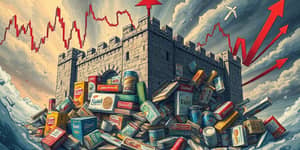
The world is witnessing a profound realignment in where investment flows, driven by shifting economic growth patterns, evolving demographics, and bold policy reforms. As traditional Western markets reach valuation peaks and slowdowns take hold, a new spotlight shines on Asia and the Middle East.
Investors seeking growth, diversification, and resilience must navigate this transition with insight, agility, and strategic foresight. This article delves into the forces shaping the eastward tilt, explores the most promising regions, outlines key risks, and offers practical strategies to harness these emerging opportunities.
Global GDP growth is projected to decelerate to 2.3% in 2025, marking the slowest expansion since the 1960s. Simultaneously, developing economies are forecast to grow at 3.8%, more than a full percentage point below their average pace in the 2010s.
However, growth prospects vary dramatically across regions. South Asia is expected to expand by 5.8%, East Asia and the Pacific by 4.5%, while Europe and Central Asia lag at 2.4%. This emerging as the new center of gravity underscores why investors are recalibrating their portfolios toward higher-growth markets.
The table below highlights regional dynamics for 2025:
The U.S. stock market trades at over 25x forward earnings, while the MSCI ACWI ex-U.S. sits at 16.3x. This capital allocation away from traditional markets has begun, as investors seek more attractive valuations and potential upside beyond expensive mega-cap tech stocks.
Understanding these valuation differentials is critical. By rotating into markets with lower multiples and robust growth trajectories, portfolios can capture public and private markets reshaping flows toward regions offering better risk-adjusted returns.
At the heart of this realignment are deep structural changes. In the Middle East, structural reforms in Gulf Cooperation Council countries have unlocked unprecedented opportunities, with governments expediting privatization and easing foreign investment regulations. Asia’s demographic dividend, with a median age nearly a decade younger than Western markets, fuels both consumer demand and workforce expansion.
Companies diversifying supply chains post-pandemic are relocating manufacturing hubs to Southeast Asia and India, channeling new supply chains for global industries. These initiatives are not transient; they reflect long-term strategies to enhance resilience and tap into emerging consumer markets.
The convergence of reforms, demographics, and digital transformation is creating fertile ground for capital deployment across the East. Investors can position for sustained growth by exploring markets that combine policy agility with robust domestic demand.
No investment comes without risks. Trade tensions, geopolitical volatility, and sustainability challenges can create headwinds, even in high-growth markets.
To effectively harness the eastward shift, investors should adopt a disciplined, research-driven approach that balances opportunity with risk management.
“Public and private markets are reshaping investment and capital flows with the Middle East and Asia emerging as the new center of gravity,” says Selim Kervanci, CEO of HSBC Bank Middle East. His observation captures the essence of a capital migration that is both data-driven and transformative.
As Indermit Gill, Chief Economist at the World Bank, notes, “Outside of Asia, the developing world is becoming a development-free zone.” This stark warning highlights the risk of remaining on the sidelines as the epicenter of growth moves eastward.
For investors, the message is clear: embracing this shift demands courage, adaptability, and a willingness to explore uncharted markets. By aligning portfolios with regions poised for growth, leveraging in-depth research, and maintaining a keen eye on geopolitical and sustainability factors, capital can be positioned to thrive in the decades ahead.
Global capital is tilting eastward. The era of seeking alpha in familiar Western strongholds is giving way to a broader, more dynamic investment landscape. Those who recognize and act on this transformation will not only enhance their returns but also contribute to the next wave of global economic progress.
References













